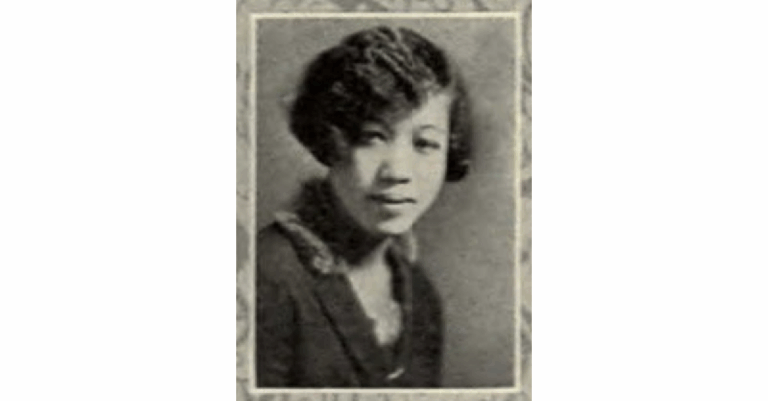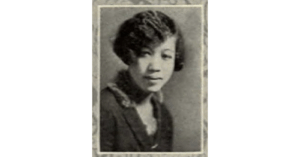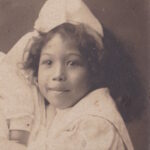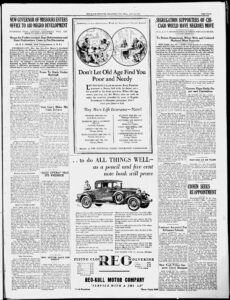
In the 1930s, Esther Ophelia Tibbs made headlines with a fast-moving actuarial career, then faded from the limelight.
In May 1937, members of the National Negro Insurance Association gathered in Augusta, Georgia, for their 17th national convention. The opening festivities included performances by local choirs and an address from the city’s white mayor; afterward, Black insurance professionals from across the U.S. weighed in on industry topics.

Especially noteworthy was the presence of three Black actuaries — “All there are in the world,” according to executive Merah S. Stuart. The former president of the association was seriously impressed by these “three young people who have finished all there is to be finished in the field of accounting.” Two of these rising stars were men: Asa T. Spaulding of North Carolina Mutual in Durham (a cousin and protégé of North Carolina Mutual chief C.C. Spaulding) and Antonio Maceo Walker of Universal Life in Memphis. And one was a woman: Esther Tibbs, representing the Afro-American Life Insurance Company of Jacksonville, Florida.
In 1937, Tibbs was thirty-one years old and at the top of her profession. She not only spoke at the Augusta convention but was elected association actuary, an officer position. Her career received frequent coverage in the Black press, particularly in Chicago, where she first made her mark at the Victory Life Insurance Company. When the association met the next year in Cleveland, Tibbs, Spaulding and Walker were all featured speakers.
But after this, their storylines diverge. Spaulding and Walker went on to distinguished careers, becoming heads of their respective companies and gaining fame for wide-ranging accomplishments. In 1939, Tibbs married a Washington, D.C., physician, moved to Georgetown and disappeared from insurance industry history.
This silence ends a striking chronicle of achievements by a young woman born in rural Iowa, raised in Ann Arbor and educated at the University of Michigan by a pioneering statistics professor. Tibbs was likely the U.S.’s first Black woman actuary and may have been its first Black actuary, period. Her career is an intriguing chapter in the story of the Black insurance industry of the 1920s and 1930s.
Early life and education: From Buxton to Ann Arbor

courtesy Armstrong Marshall.
Tibbs was born on May 24, 1906, in Buxton, Iowa, a then-thriving coal-mining community where a majority Black population lived in prosperous coexistence with white European immigrants. Her mother, Mary Ann (“Mollie”), taught music; her father, Oscar, was a lawyer who later held part interest in a grocery store. Unfortunately, he struggled as a grocer. The partnership dissolved, as did the Tibbs’ marriage, when Esther was still a toddler.
Mollie Tibbs returned to her hometown of Ann Arbor, Michigan, and Tibbs grew up mostly in the household of her maternal grandmother, Esther Dickson, a laundress. At Ann Arbor High School young Esther made the honors list and graduated in the spring of 1923, then headed straight into a summer program at the University of Michigan.
Even at this early stage, the Black press was taking note. In August 1923, the Chicago Defender hailed 17-year-old Tibbs’ entrance into the paper’s Bud Billiken youth club. “Even though she has not been a member of the club very long, we can frankly say that she is 100 per cent,” the writer enthused. “Esther is now attending the University of Michigan summer school. Isn’t that nice?”
Tibbs earned her Bachelor of Science degree from Michigan in June 1926, with most of her coursework in mathematics, according to university records. From later developments in Esther’s career, it’s also apparent that her abilities caught the attention of Harry C. Carver (1890–1977), a pioneer in developing mathematical statistics as an academic discipline.
As a brilliant young Michigan graduate, Carver was recruited by his alma mater in 1916 to beef up the university’s new actuarial science program with probability and statistics courses. Eventually he founded The Annals of Mathematical Statistics to publish papers from the fledgling field of statistical analysis. When Tibbs studied at Michigan, Carver was still an associate professor. (He would become a full professor in 1936.) He was gifted, warmhearted and eccentric, a teetotaler who lived on milk and crackers. And in the words of a colleague, he was “a truly inspiring teacher who transmitted his enthusiasm for his subject to his students.”
As Tibbs described it several years later, choosing to become an actuary was almost inevitable:
When making up my schedule of classes [in] the second part of my sophomore year at the University of Michigan, a friend, Sarah Pelham, was glancing through the catalog. She started laughing and said, “Why, Esther, I do not see what more mathematics you can take except that in actuarial science. Why not add a little economics to your program and become an actuary?”
I replied: “What is an actuary?” She answered: “I do not know, except that it is something that no Negro is.” Therefore, I started actuarial mathematics and became subsequently an actuary.
Tibbs went to work for the Liberty Life Insurance Company in Chicago after completing her bachelor’s degree, although newspaper sources don’t specify her responsibilities there. Social news items also chronicle more festive times in fall 1927 — socializing at dances and motoring to Urbana to catch the Illinois-Michigan football game.
Amid the fun, Tibbs retained a yearning for learning. Census data indicates that she had a year of postgraduate level education, and according to news accounts, she returned to the University of Michigan for further study in mathematics, earning a master of science in 1929. Soon afterward, her insurance career really took off.
Triumphs at Victory Life Insurance

“Stenographer, Insurance” is the occupation listed for Esther O. Tibbs, single, age 23, in the federal census of April 1930 for Chicago. She would not remain single or a stenographer much longer. That September in Ann Arbor, she married lawyer Theophilus M. Mann, a native of Springfield, Illinois. Soon after, a group of Chicago election commissioners congratulated the newlyweds at their Prairie Avenue home and presented them with an end table. As the Chicago Defender noted, the Manns were a couple on the rise.
Mrs. Mann, formerly Miss Esther Tibbs, is a graduate of the University of Michigan and is an actuary with the Victory Life Insurance company. Attorney Mann, graduate of the University of Illinois, holds an important position in the office of the recorder of deeds.
At Victory Life, Tibbs-Mann joined a business empire built by Louisiana-born Anthony Overton, “widely regarded as one of the twentieth century’s most significant African American entrepreneurs,” writes his biographer Robert E. Weems Jr. In Kansas City, Overton founded the Overton Hygienic Manufacturing Company, a major producer of beauty products for Black women. He came to Chicago as the Great Migration era dawned, expanding into magazine and newspaper publishing. In the 1920s, he added the presidency of the Douglass National Bank to his portfolio, then the Victory Life Insurance Company, organized in 1924.
Overton brimmed with drive, charisma and (to his critics) ruthlessness. He was also unusually open to hiring women for key positions in his companies, Weems observes. One example was Esther’s friend Olive Diggs, eventually the editor of Overton’s Chicago Bee newspaper. Visiting Chicago a decade after moving away, Esther “[dropped] by the Bee to say ‘hi’ to Olive M. Diggs, long-time friend of Douglass National Bank-Victory Life insurance days.”
Victory Life proved a good fit for a talented woman with a statistics background. In March 1931, the Baltimore Afro-American declared that “Victory Life is Now Million Dollar Co.” and listed Mrs. Esther Tibbs-Mann, actuary, among the company’s officers. Also that year, Tibbs-Mann was inducted into the American Statistical Association as “the first Race person ever elected to membership,” the Chicago Defender reported. Her sponsor was Harry C. Carver, now head of the statistical mathematics department at the University of Michigan.
In early 1932, the Defender published an admiring profile of Tibbs-Mann, praising her admission to the American Statistical Association. It tacked on a helpful explanation of her profession: “… an official in a life insurance company who evaluates life insurance premiums, benefits and risks.” And Who’s Who In Insurance’s 1932 edition named Tibbs-Mann as company actuary in a list of Victory Life’s officers. At this point, her actuarial colleagues Asa T. Spaulding and A. Maceo Walker had yet to appear in the directory. (Spaulding joined North Carolina Mutual in January 1933, according to Weems’ study Black Business In The New South, while a biographical sketch of Walker says he joined the board at Universal after earning his master’s in actuarial science from Michigan in 1935.)
Navigating storms
In the background simmered the deepening Great Depression, to which not even a tycoon of Anthony Overton’s caliber was immune. Among the problems besetting Overton after the Crash of ’29 were dwindling deposits in his Douglass National Bank, along with heavy investments in a real estate market whose bubble had burst with a vengeance.
Soon the spotlight also fell on iffy finances at Victory Life. As Weems details, Overton faced scrutiny by regulators in three states, not to mention increasingly contentious Victory Life board members, two of whom launched an in-depth investigation of the company. Overton countered by summoning a board meeting to oust the whistleblowers, but a circuit court judge slapped down an injunction forbidding any interference.
The bombshell findings hit the headlines in March 1932. The Chicago Defender bluntly accused Overton of milking Victory Life for the benefit of himself and his family, while the internal probe turned up numerous examples of Victory’s income being funneled into Overton’s other endeavors. Even worse was the use of Victory Life cash to prop up Douglass National Bank through stock purchases and a loan to salvage a failed Douglass real estate deal.
Overton’s reputation was dealt a crippling blow. As calls mounted for his removal as Victory’s president, he successfully petitioned for a court-appointed receiver to take over the company’s administration. The judge named a white official, a bitter pill for observers in the Black business community. When the receiver presented his findings to stockholders in December 1932, at least one reporter caught a whiff of condescension: “The receiver attempted to pat the colored folks on the back and stated he never would have done for a white company what he was doing for this colored company.”
Assisting the receiver was Tibbs-Mann, a close-up witness to Victory Life’s painful deterioration. After Overton’s attempt to oust his board opponents, she was named Victory’s temporary administrator, and in May 1932, was elected an assistant secretary. She might have been gratified when the receiver praised the work of Victory’s office staff, but then again, perhaps not. “[He] said they were the peer of any businesswomen in America,” ran a sharp-tongued description in the Pittsburgh Courier. “This was undoubtedly true, and, according to the opinion of one of those in authority, was about the only true thing he said.”
In the spring of 1933, Victory Life was reorganized as Victory Mutual Life. Anthony Overton was officially out as president, and a revamped leadership managed to steady the rocking boat. But by this time, Tibbs-Mann had other storms to weather. She filed for divorce from Theophilus Mann in October 1933, which set off a spate of gossipy coverage. The Defender ran his-and-her portraits captioned “Sues Hubby” and “Sued by Wife.” The Pittsburgh Courier quipped it was a matter of “give me liberty or give me love” — a reference to a current jazzy hit song.
Tibbs continued at Victory Mutual until 1936, when she left to become an actuary with the Afro-American Life Insurance Company in Jacksonville, Florida. She was joining another noteworthy Black insurance enterprise, founded in 1901 and expanding to include branch offices in Orlando, Daytona, Tallahassee and Atlanta. Despite the Depression’s ravages, Afro-American Life’s leadership had “piloted the ship safely into the harbor” with an annual income of nearly a million dollars and reserves of over half a million, according to a company history.
In Florida, Tibbs’ professional energy continued strong. She headed to those bustling conventions of the National Negro Insurance Association in 1937 and 1938, joining rosters of speakers discussing “every phase of the insurance business from the viewpoint of executive and policyholder.” She also researched industry-wide trends for Black insurers during the run-up to the Crash. Her analysis of annual statements from National Negro Insurance Association member firms was cited in a 1939 Howard University study examining factors leading to the collapse of the Washington, D.C.-based National Benefit Life Insurance Company. National Benefit fell in 1931, weakened by a poorly timed merger and overextension into real estate investments on the eve of the Depression — problems that likely resonated for observers like Tibbs.
Quiety legacy: Esther Tibbs-Marshall’s lasting impact
This annual statement analysis is one of the last indications of Tibbs’ professional life that can be found to date. The 1939 Jacksonville city directory still lists “Tibbs, Esther, (c[olored]), actuary Afro-Am Life Ins Co.,” but the most significant event recorded about Esther that year is her second marriage, to physician C. Herbert Marshall, an accomplished and energetic doctor from Washington, D.C.
It’s not clear how Tibbs met Marshall, although given their work in the medical and life-insurance fields, they might have met professionally. Shortly after their July 1939 marriage they moved to Georgetown, where Marshall ran a medical practice founded by his father. Also that year, he became the head of the D.C. chapter of the NAACP and campaigned against police brutality and discrimination in government employment.
Much more can be read about Marshall’s activities in the following decades: crusading for the American Medical Association to admit Black physicians in the South, spearheading neighborhood improvements in Georgetown and pushing to eliminate segregated public spaces. He became celebrated as Georgetown’s unofficial “mayor” and a keeper of its rich history.
For Tibbs-Marshall, however, data points are sparse. A 1940 membership listing of the American Statistical Association includes “Marshall, Mrs. Esther Tibbs,” consulting actuary. In her son’s 1942 birth announcement, she’s described as “the former Esther V. [sic] Tibbs, one of the few Negro insurance actuaries.” Five years later, the Chicago Bee noted Esther’s quick visit with her old friend, newspaper editor Olive Diggs, and in the 1950 census, her occupation is given as “Misc. accounting work/own business.” Later references are limited to mentions in city directories and relatives’ obituaries.
Tibbs-Marshall died on October 19, 1983, five months after the passing of her husband of more than 40 years. Her death notice in the Washington Post describes her as a beloved wife, mother and grandmother, a woman with many relatives and friends. Her later life was private and largely unknowable, at least through archival sources. While it’s tempting to characterize Tibbs’ story as one of professional energies bottled up in a domestic sphere, it would be unwise to make sweeping assumptions about her post-1939 career from those blank spots in the newspapers.
What is available is the record up to 1939, and a fascinating record it is. Unlike her 1930s colleagues Spaulding and Walker (son of Universal Life founder Joseph Edison Walker), Tibbs had no obvious family connection to the insurance industry, no insider to mentor her. She was, however, a bright young woman who parlayed her University of Michigan statistical training into dynamic achievement, building an insurance career that was unusual for many women of her time. Despite its frustrating gaps, the archival record preserves a roster of accomplishments deserving of a closer look.
Liz Haigney Lynch is a genealogist and writer whose work has
appeared in the Miami Herald, the Sun-Sentinel of Fort Lauderdale,
and the Chicago Sun-Times. She is vice president of the
Association of Professional Genealogists’ New Jersey chapter.













